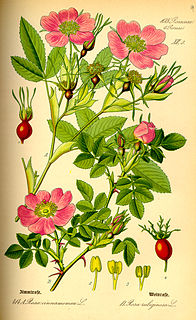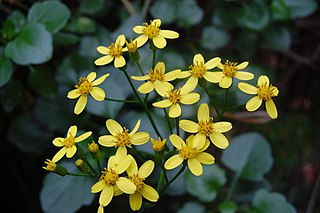
The Apiales are an order of flowering plants. The families are those recognized in the APG III system. This is typical of the newer classifications, though there is some slight variation and in particular, the Torriceliaceae may be divided.

Flowering plants, also known as Angiospermae, meaning hidden seeds in Greek, are the most diverse group of land plants with 64 orders, 416 families, approximately 13,000 known genera and 300,000 known species.

The Malpighiales comprise one of the largest orders of flowering plants, containing about 36 families and more than 16,000 species, about 7.8% of the eudicots. The order is very diverse, containing plants as different as the willow, violet, poinsettia, manchineel, rafflesia and coca plant, and are hard to recognize except with molecular phylogenetic evidence. It is not part of any of the classification systems based only on plant morphology. Molecular clock calculations estimate the origin of stem group Malpighiales at around 100 million years ago (Mya) and the origin of crown group Malpighiales at about 90 Mya.

Rosales is an order of flowering plants. It is sister to a clade consisting of Fagales and Cucurbitales. It contains about 7,700 species, distributed into about 260 genera. Rosales comprise nine families, the type family being the rose family, Rosaceae. The largest of these families are Rosaceae (90/2500) and Urticaceae (54/2600). The order Rosales is divided into three clades that have never been assigned a taxonomic rank. The basal clade consists of the family Rosaceae; another clade consists of four families, including Rhamnaceae; and the third clade consists of the four urticalean families.

The Saxifragales (saxifrages) are an order of flowering plants (Angiosperms). They are an extremely diverse group of plants which include trees, shrubs, perennial herbs, succulent and aquatic plants. The degree of diversity in terms of vegetative and floral features makes it difficult to define common features that unify the order.

The Vitaceae are a family of flowering plants, with 14 genera and around 910 known species, including common plants such as grapevines and Virginia creeper. The family name is derived from the genus Vitis.

Under the International Code of Nomenclature for algae, fungi, and plants (ICN), Rosidae is a botanical name at the rank of subclass. Circumscription of the subclass will vary with the taxonomic system being used; the only requirement being that it includes the family Rosaceae.

The Celastrales are an order of flowering plants found throughout the tropics and subtropics, with only a few species extending far into the temperate regions. The 1200 to 1350 species are in about 100 genera. All but seven of these genera are in the large family Celastraceae. Until recently, the composition of the order and its division into families varied greatly from one author to another.

The Angiosperm Phylogeny Group, or APG, is an informal international group of systematic botanists who collaborate to establish a consensus on the taxonomy of flowering plants (angiosperms) that reflects new knowledge about plant relationships discovered through phylogenetic studies.

The eudicots, Eudicotidae or eudicotyledons are a clade of flowering plants mainly characterized by having two seed leaves upon germination. The term derives from Dicotyledons.

The rosids are members of a large clade of flowering plants, containing about 70,000 species, more than a quarter of all angiosperms.

In the APG IV system (2016) for the classification of flowering plants, the name asterids denotes a clade. Well known plants in this clade include the common daisy, forget-me-nots, nightshades, the common sunflower, petunias, yacon, morning glory, sweet potato, coffee, lavender, lilac, olive, jasmine, honeysuckle, ash tree, teak, snapdragon, sesame, psyllium, garden sage, table herbs such as mint, basil, and rosemary, and rainforest trees such as Brazil nut.

Peridiscaceae is a family of flowering plants in the order Saxifragales. Four genera comprise this family: Medusandra, Soyauxia, Peridiscus, and Whittonia., with a total of 12 known species. It has a disjunct distribution, with Peridiscus occurring in Venezuela and northern Brazil, Whittonia in Guyana, Medusandra in Cameroon, and Soyauxia in tropical West Africa. Whittonia is possibly extinct, being known from only one specimen collected below Kaieteur Falls in Guyana. In 2006, archeologists attempted to rediscover it, however, it proved unsuccessful.

In plant taxonomy, commelinids is a clade of flowering plants within the monocots, distinguished by having cell walls containing ferulic acid.
Dipentodon is a genus of flowering plants in the family Dipentodontaceae. Its only species, Dipentodon sinicus, is a small, deciduous tree native to southern China, northern Myanmar, and northern India. It has been little studied and until recently its affinities remained obscure.

Huerteales is the botanical name for an order of flowering plants. It is one of the 17 orders that make up the large eudicot group known as the rosids in the APG III system of plant classification. Within the rosids, it is one of the orders in Malvidae, a group formerly known as eurosids II and now known informally as the malvids. This is true whether Malvidae is circumscribed broadly to include eight orders as in APG III, or more narrowly to include only four orders. Huerteales consists of four small families, Petenaeaceae, Gerrardinaceae, Tapisciaceae, and Dipentodontaceae.

Lepidobotryaceae is a flowering plant family in the order Celastrales. It contains only two genera, each with a single species: Lepidobotrys staudtii and Ruptiliocarpon caracolito.

Mesangiospermae is a clade of flowering plants (angiosperms), informally called "mesangiosperms". They are one of two main groups of angiosperms. It is a name created under the rules of the PhyloCode system of phylogenetic nomenclature. There are about 350,000 species of mesangiosperms. The mesangiosperms contain about 99.95% of the flowering plants, assuming that there are about 175 species not in this group and about 350,000 that are. While such a clade with a similar circumscription exists in the APG III system, it was not given a name.

The superasterids are members of a large clade of flowering plants, containing more than 122,000 species.


















